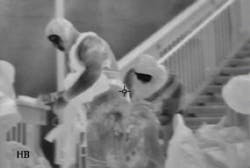Detecting the location or hiding spot for a fugitive or victim can be a daunting task even with the use of thermal imagery. Some operators get spoiled by the increased graphics and detail of quality imagers. We need to realize that we are not always going to get a perfect picture during our search or operation. The questions we always need to ask ourselves while using a TI are: What is it? And Why is it different?
An example of this would be if we are searching for a human. Remember the perfect human silhouette is not always going to be available. It may be hidden or blocked by a tree. Therefore, we may only get a piece of the picture like a foot or hand. First, set a baseline for the area that you are searching. What is the norm for the area? Then as you scan, you detect an anomaly. What is it? You see a glowing object near a tree. Why is it different? The object is surrounded by dark grey and black and stands out white in color.
To help keep it fresh in your mind, I use this acronym for my students: D.R.I.
- DECTECT - as you are scanning you detect the anomaly.
- RECOGNIZE - you recognize that it is very different from what the norm is from the area.
- IDENTIFY or INVESTIGATE - you need to identify what the object is or investigate why this object is different from the surrounding area.
Remember to approach the area with caution and NEVER approach without back up. Once contact is made with the anomaly it may be time to use tactical lighting or night vision. With these other technologies we can make a positive ID on our subject. For the most part the court will not allow us to make an ID solely by using thermal imaging technology.
Thermal imagery in the law enforcement world is primarily a detection or locater device. With tactical lighting or night vision we use the acronym L.I.E.
- LOCATE - attempt to locate the target.
- IDENTIFY - you have to make the ID that it is your suspect.
- ENGAGE - you decide to engage the suspect with verbal commands, less lethal devices or firearms if the suspect is armed or uncooperative.
These formulas will help you bring all your low light tools together for maximum effect and help you answer the questions: What is it? And Why is it different?
Stay Safe!
About the Author
Brian Stas
Brian Stas is a Thermal Imaging training Specialist for law enforcement at Bullard. He is certified as a Fitness Instructor and a Firearms Instructor by the National Riffle Association. Brian is also a certified Instructor in numerous tactical applications and specializes in training.
Brian attended Westchester Community College, where he studied Criminal Justice. Brian has been a law enforcement professional for over 12 years. He has served in many capacities as a Master At Arms with the US Navy, a Trooper with the Connecticut Police Department and a Police Officer for the New York Police Department. Now retired from law enforcement, Brian continues to teach and train with Special Operations from all over the
